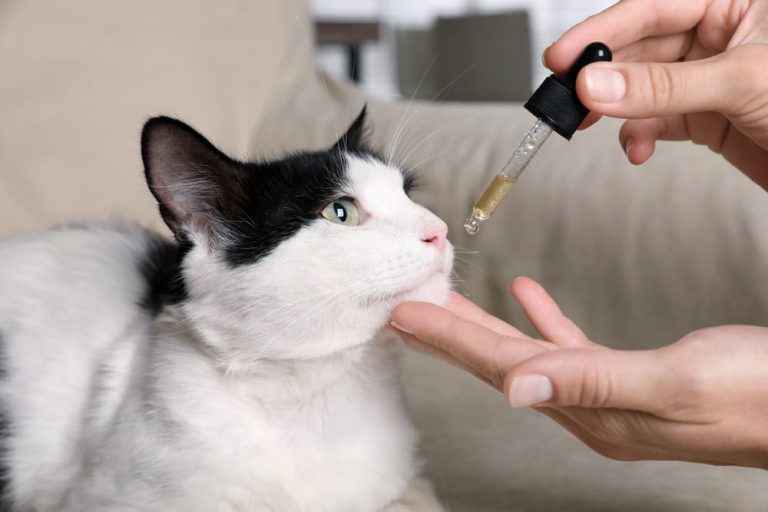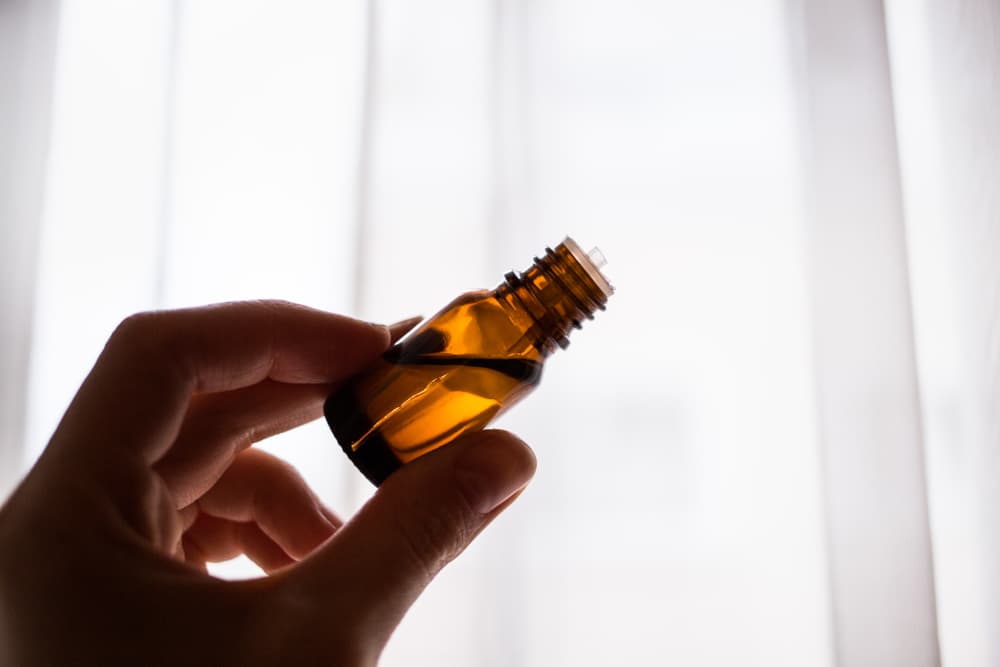How To Give Cats Liquid Medicine

At some point or another in their lives, most cats are likely to need a dose or two of medication. And for many pet parents, the prospect of administering medicine to their cat is enough to trigger a jolt of anxiety. Cats are independent creatures that do not like to stray from their daily habits and routines. They also have a keen sense of smell and taste. This often makes administering any form of medication a challenge.
Whether your cat’s medication only comes in liquid form, or you simply prefer the idea of dosing your cat with liquid medicine over pills, here’s a helpful guide devoted specifically to liquid medications for cats. We’ll cover why they are necessary for some cats, common liquid medications, how to give a cat liquid medicine, and what other options are available when your kitty refuses medication.
Why Cats May Need Liquid Medicine

Many oral medications for cats are available in both pill and liquid forms. If this is the case, your cat’s veterinarian may give you the choice between the two. Whether a pill or liquid will be easier to give is very dependent on the medication, the individual cat, and the pet parent’s comfort level. A recent study showed that most owners preferred giving their cat a pill over a liquid, but that cats tended to prefer the taste of liquid over pills (1).
Sometimes pet parents will not have the option to choose between giving a pill or a liquid because a medication is only readily available in one format. Some medications, such as the non-steroidal anti-inflammatory drug meloxicam, are only available in liquid form for cats.
Liquid medications are sometimes preferable when it comes to providing a smaller or more precise dose of medicine. For example, if a tiny kitten needs medication, the veterinarian may be more inclined to prescribe a liquid, as a pill might contain too large of a dose.
In some cases, the tablet form of a medication may pose health hazards that the liquid form does not. Certain medications, such as the antibiotic doxycycline, can become caustic if taken in tablet form and not followed up with water. That could lead to esophageal strictures—a serious condition that causes narrowing of the esophagus, the tube that connects the throat to the stomach.
Common Liquid Medicine for Cats

There are many different types of medications for cats that come in liquid form, which treat a variety of conditions. Here’s a list of the most commonly prescribed liquid medications and what they do:
- Gabapentin – This medication is commonly used to treat pain and to help to decrease stress and anxiety associated with veterinary visits and other challenging events.
- Prednisolone – This is a steroid that is used to treat or manage a variety of conditions including allergies and autoimmune disorders.
- Meloxicam – This is an anti-inflammatory drug commonly used to help relieve short-term pain, such as post-surgery recovery pain, or to help manage chronic inflammatory conditions such as arthritis.
- Antibiotics (amoxicillin or amoxicillin with clavulanic acid) – These antibiotics are used to treat a variety of infections, from respiratory disorders to wounds.
- Dewormers (pyrantel, sulfadimethoxine, fenbendazole) – These help treat or prevent intestinal parasite infestations.
How to Give Cats Liquid Medicine

Ideally, it’s best (for both pets and parents) to start training cats on how to take medication when they are kittens. A good way to begin is by getting your kitten used to regular oral examinations. Gently open your kitten’s mouth, then reward them with treats, petting, and encouragement. This not only helps you identify any issues with your cat’s oral health, but it will also help your cat feel more comfortable opening their mouth when it comes time to administer medication.
Before giving your cat liquid medication, it’s also important to make sure you are prepared with everything you will need to set yourself up for success. You will need a thick bath towel, gloves, the appropriate syringe or dropper required to measure and administer the medication, and your cat’s favorite treats or wet food. It is also helpful to have someone else available to help you if you know your cat is difficult to medicate.

If your cat is currently feeling fine and eating well, you can first try hiding the liquid medication in a small amount of tasty wet food—about the size of a meatball. The stinkier the food, the better it will hide the smell of the medication. Do not apply the medication to an entire meal’s worth of wet food. There’s always a chance that your cat may not eat all the food and won’t get the full dose of medication. Also, if you have multiple cats, you want to be sure that no other cats take medication not meant for them.
However, adding medication to food is not always recommended. If you have an ill cat who is not eating well, adding medication to their food could create food aversion—meaning your cat might associate the yucky taste of the medicine with their food and be even less inclined to eat.
If this is the case, or your cat doesn’t fall for the meatball trick, the next thing you can try is gently swaddling your cat in a towel and placing them on your lap with their head facing away from your body. This way, you can approach your cat’s mouth from the side with the medicine dropper. That may feel less threatening to your pet than a head-on approach. This position also keeps your cat’s mouth further from your body and allows you to use your arms and elbows to gently secure your cat and prevent an escape.
Next, offer the syringe or dropper to your cat and let them taste the medication. If you’re lucky, your cat might then readily accept the medication and you can gently trickle it into their mouth. However, many cats may still resist. Sometimes it can help to put a small amount of a squeezable treat to the tip of the dropper or syringe. Once your cat begins to lick off the treat, depress the syringe or dropper into their mouth. You can follow up the medication with more of the tasty treat as a reward for taking the medication.
If the above options do not work, here’s another approach: First, use your non-dominant hand to hold your cat’s head steady. If you position your middle finger underneath your cat’s jaw, your index finger on their forehead, and your thumb behind the head at the base of the skull, this will help you control their head and prevent you from getting bitten.

Next, with your dominant hand, grip the syringe and (coming from the side) slide it in through the corner of your cat’s mouth, into the cheek pouch. Quickly squirt the medication inside the cheek pouch, then remove the syringe and gently hold your cat’s mouth closed. To encourage your cat to swallow, you can rub their throat or gently blow on their nostrils.
When giving liquid medicine to cats, make sure their head isn’t tilted back and that you never forcefully squirt the liquid into the back of their mouth as that can cause your cat to inhale the medication. If your cat is very squirmy, having one person to hold your cat’s body and one person to administer the medication can be very helpful.

As always, try to make this as positive an experience as possible, and follow up the medication by rewarding your cat with something they like such as food, playtime, or a gentle brushing session.
If you have a cat that is becoming very upset with you while you are trying to medicate them, it’s a good idea to take regular breaks and try different methods. Be conscious of your cat’s body language to avoid bites and scratches. Pinned back ears, growling, or hissing is your cat’s way of warning you to back off. If you are ever bitten by your cat, make sure to clean the wound thoroughly and contact your physician right away.
What if My Cat Won’t Take Liquid Medication?

If you have tried all of these methods and you are still unable to give your cat liquid medication, speak with your veterinarian about other options for administering the drug. In some cases, the medication can be compounded into a different form, such as a tuna flavored liquid, a chewable treat, or a flavorless capsule. Certain medications are also available as transdermal creams that are applied to the skin on the ear flaps.
Some medications are not available in alternate forms. In those cases, you may be able to bring your cat into the veterinarian’s office when it comes time for medicating, where a trained professional can do it. Or, better yet, ask if a veterinary technician can come to your home and administer the medication.
Using a calming pheromone diffuser or spray can also help to calm your cat down during medication time.
Remember that cats are very attuned to our emotions. If you remain calm and collected when it comes time to medicate your cat, that may help calm them down, as well. Work slowly and reach out to your veterinarian for advice if things are not going well.









